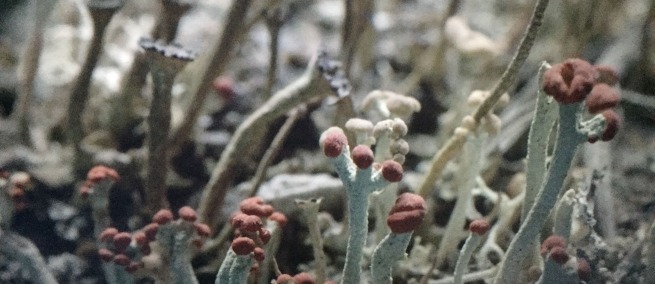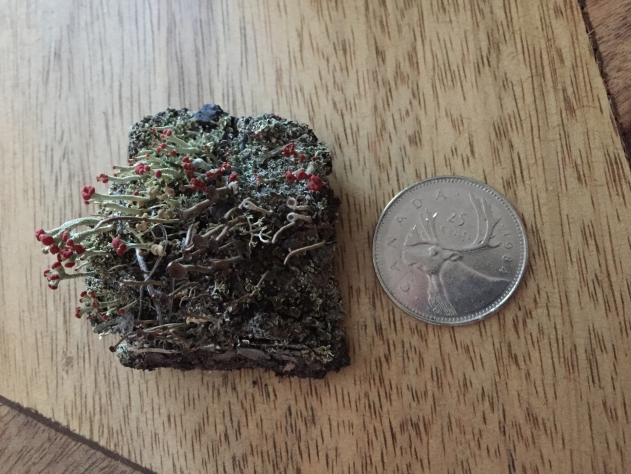
Premiering at Sundance 2020, LICHEN is a short film written and directed by Lisa Jackson, which takes a close look at a few of the 5,600 lichen species occurring in North America. Approaching lichens from both a scientific and philosophical perspective, the film suggests what we might learn from these organisms that live in dynamic tension with their environment, often dying when that environment changes. We spoke with Lisa Jackson and lichenologist Trevor Goward, who lends his voice to the film, about these overlooked species.
Science & Film: Lisa, how did this project begin, and why did you want to collaborate with a lichenologist?
Lisa Jackson: I had been commissioned by Janine Marchessault, an academic and curator here in Toronto, to be one of five artists making a short IMAX film. Around this time I was reading Scientific American, and there was this fantastic article about lichen including a significant profile of Trevor and his approach to science. There were a bunch of photographs and I thought lichen were stunning—so magical and otherworldly-looking. I had no idea there was so much variety among lichen. Also, reading the article about how lichens defy scientific definition also captivated me. And Trevor’s approach—he studies lichen and sees it in a holistic way—all of those things captured my imagination. I contacted Trevor and he was very gracious and open to meeting in person. We did an interview and he also collected the gorgeous lichen specimens, which we shipped to Toronto. For the film, we shot them in a studio with special lighting.
S&F: Trevor, what was your reaction when Lisa reached out?
Trevor Goward: My reaction was quite enthusiastic. I saw her project as an opportunity to get some exposure for an underrated and overlooked group of organisms. Much of what's going wrong with our future is rooted in our deepening disconnect with the living world. Anything that might help to bridge that disconnect, I’m very keen to be involved in. And besides, Lisa sounded like a really nice person. It seemed like a natural thing to do.
Within lichenology you often hear the complaint that lichens get short shrift from everybody. But, problematically, when most lichenologists talk about lichens, they talk about details that are not going to grab people who aren’t already engaged. For many years I’ve been thinking about this, about the question, what’s special about lichens? Working with Lisa gave me an opportunity to share some of my thoughts.

Process shot from LICHEN set, courtesy of Lisa Jackson
S&F: Can you explain what your general approach to lichens is?
TG: I try very hard to walk the line between the arts and the sciences or, to put that another way, between how things feel and what things are. I’m not afraid to take the findings of scientific research and squeeze out various implications for our understanding of what it is to be human. I think that’s probably what Lisa found some connection with. It’s a lifetime study, and what Lisa’s done is give it some time in the humanities sun, and I’m delighted about how this has turned out. The lichenological community has no idea what’s coming.
I should say that the first thing you should know about lichens is that they’re composite organisms, a symbiose of algae and fungi. Another way of saying this is that lichens exist in a portal, a doorway. If you look out from this doorway in one direction what you see is an organism, a lichen. But if you look out the same doorway in the other direction, what you see is an ecosystem, the various species of fungi and algae that make up the lichen. Lichens span both of those perspectives at the same time. They include more than one narrative, more than one way of seeing. They’re a biological paradox.
LJ: I could have called the film paradox, I realize now!
S&F: Can lichens be used as environmental indicators?
TG: Lichens are a partnership, a marriage. Anything in the environment that stresses one or more of the partners can cause the marriage to fall apart—at which point the lichen dies. In a sense, lichens are crystallizations of place, they’re there year-round. For a lichen to persist, say, on a tree branch, a whole complex set of environmental conditions—illumination, atmospheric chemistry, frequency of wetting, rates of drying, and so on—needs to be in place. Change any of that, and the lichen soon disappears.
Returning to your question, I suppose lichens are best known as indictors of air pollution. The more species of lichens, the cleaner the air, the fewer, the fouler the air. But that's really just the beginning. I doubt there’s a lichen anywhere that couldn’t teach us something about where it grows: the frequency of dew fall, the strength of the wind, the depth of the winter snow, the chemistry of the soil, the places where birds like to perch, that sort of thing.
LJ: What a remarkable group, that it thrives in places where many other living things can’t, like in the arctic or up high in the Himalayas or hanging off a tree–it doesn’t necessarily need dirt. Lichens seem so remarkable and resilient, but with their sensitivity to pollution they are simultaneously delicate. As a filmmaker I’m look for symbols or metaphors, and often in the natural world. With lichens I saw something that I felt communicated something magical about the living world that could speak to a wide audience, that would be really accessible for people who aren’t necessarily into science or small organisms.
S&F: Lisa, since this was a commission, you knew at the outset that it would be a short film. How did you approach the photography and the story arc?
LJ: I quite like short films. Short films often are seen as a steppingstone to long films, but I think the ability to experiment in short films is amazing; they can be like a sketchbook. I didn't ever think that I would go shoot lichens in the forest as in a National Geographic approach. I always knew that there would be an abstractness about it and that I would play with perception.
To shoot them close up we used macro lenses—100x to 300x magnification. And we actually shot in 3D so that you could really feel like you’re inside these landscapes of lichen. The film was commissioned for an IMAX screen, so that was on the table to begin with. I wanted it to feel otherworldly, and so what I did is I looked at each lichen and what it had going on. Some of them I felt would be really interesting graphically. Others, we could travel over as if it was an aerial shot of a forest. Other ones felt like they were their own tiny planets; I wanted to be able to rotate them and surround them in black as you see at the end of the film. In studio we had sliders and various rotating plates and lights that we could manipulate to move around and create the shadows that you see.
Process shot from LICHEN set, courtesy of Lisa Jackson
S&F: Each specimen has such an individuality in the film.
LJ: Oh, we became VERY attached, I have to tell you. The lichen from the film are now residing in many of our homes. That was the crew gift–people were allowed to bring a lichen of their choice home with them. We had nicknames for our favorites. Lichens have funny names already, as you might’ve noticed in the credits, but then we made up our own names.
S&F: That’s the beauty of the film in some ways, that it makes you look at these species differently. I’m actually a member of the mycological society, and when I started we would go on walks and I would be looking up at trees or the sky, and now I stare at the ground in a way that I never used to.
TG: That’s exactly right, I’m really happy to hear that. Don’t stop now.
LJ: The ideas raised get at a fundamental shift in perspective that is so important in these times of climate crisis and the resource extraction economy that we live in. I am Indigenous, Anishinaabe, and all of my work is centered on Indigenous subject matter. I felt kinship with the ideas that were expressed through Trevor’s views of lichens. What I hope is that the film offers a hopeful, inspiring, perspective. On how we can relate to the natural world that could have an impact on the way we take care of the environment–more on a philosophical level. Activism work is extremely important, but I find myself as an Indigenous creator seeking to translate concepts and values and worldviews to a wider audience. Even though Trevor is not Indigenous, I felt that there was so much resonance between our worldviews. Abstraction allows us to hopefully open up our minds to thinking in a different way.
S&F: What’s happening with the film after Sundance?
LJ: I hope it will get carried off on the wind of Sundance to wherever people find it interesting. I also hope it will go to science museums and reach a broad public. It was shot in such high resolution that I’ve even considered that some of the raw footage might be projected onto the sides of buildings in cities and in that way “recolonize” urban landscapes and make us think more deeply about what’s not there. It would be kind of cool, because lichen does grow on rock, and lichen can break down rock into soil which then allows for other things to grow, so there's something really poetic if lichen could large-scale latch on to buildings, even visually.

Lisa Jackson, photo by Emily Cooper
LICHEN is written and directed by Lisa Jackson, edited by Terra Jean Long, and filmed by Bob Aschmann. Jackson’s other work includes the 2018 VR piece BIIDAABAN: FIRST LIGHT which premiered at the Tribeca Film Festival. Stay tuned to Science & Film as LICHEN continues its journey.
TOPICS